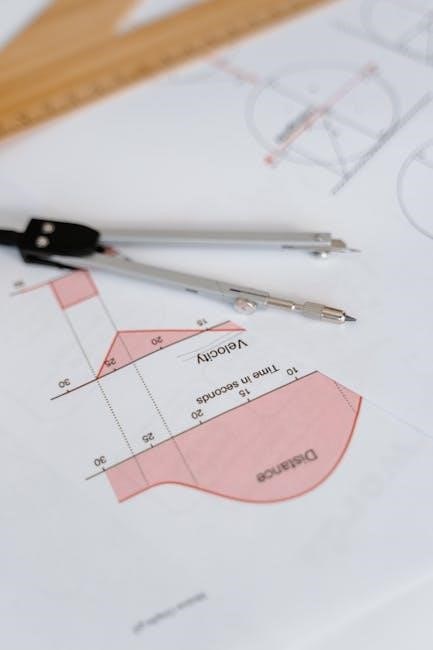unit 7 test study guide right triangles and trigonometry

Right triangles and trigonometry are fundamental in mathematics, studying relationships between sides and angles. Essential for solving problems in geometry, physics, and engineering, they form the basis of trigonometric functions and the Pythagorean theorem, crucial for real-world applications.
1.1 Definition and Importance of Right Triangles
A right triangle is a triangle with one 90-degree angle, where the sides opposite the angles are called the legs, and the longest side is the hypotenuse. These triangles are foundational in geometry and trigonometry, as they simplify complex problems into manageable ratios and relationships. Their importance lies in their applications across various fields, including physics, engineering, and astronomy, where understanding right triangles is essential for calculations involving distances, forces, and angles. They also form the basis for defining trigonometric functions like sine, cosine, and tangent.
1.2 Overview of Trigonometry and Its Applications
Trigonometry is a branch of mathematics that explores the relationships between angles and sides of triangles, particularly right triangles. It involves the study of sine, cosine, and tangent functions, which are essential for solving problems in various fields. Trigonometry has wide-ranging applications in physics, engineering, navigation, and astronomy, where it is used to calculate distances, heights, and angles. Its principles are also vital in surveying, architecture, and even music. Understanding trigonometry is crucial for solving real-world problems, making it a fundamental tool in both academic and professional settings.
The Pythagorean Theorem
The Pythagorean Theorem relates the sides of a right triangle, stating that the square of the hypotenuse equals the sum of the squares of the other two sides.
2.1 Statement of the Pythagorean Theorem
The Pythagorean Theorem states that in a right triangle, the square of the hypotenuse (the side opposite the right angle) is equal to the sum of the squares of the other two sides. Mathematically, it is expressed as (a^2 + b^2 = c^2), where (a) and (b) are the lengths of the legs, and (c) is the length of the hypotenuse. This fundamental principle is essential for solving problems involving right triangles and has numerous applications in geometry, physics, and engineering.
2.2 Proof and Derivation of the Theorem
The Pythagorean Theorem can be proven geometrically by constructing squares on each side of a right triangle. The area of the square on the hypotenuse equals the sum of the areas of the squares on the other two sides. This visual demonstration shows that (a^2 + b^2 = c^2). Another method involves rearranging the triangle within a larger figure, highlighting the equality of areas. These proofs confirm the theorem’s validity, making it a cornerstone of geometry and trigonometry, essential for solving right triangle problems and real-world applications.
2.3 Applications in Right Triangle Problems
The Pythagorean Theorem is widely used to solve right triangle problems, such as finding unknown side lengths or verifying if a triangle is right-angled. It is essential in various fields like construction, physics, and engineering. For example, architects use it to design buildings, while physicists apply it in projectile motion calculations. Additionally, it aids in determining distances in navigation and astronomy. Mastery of this theorem is crucial for solving real-world problems efficiently, making it a foundational tool in mathematics and its practical applications.

Trigonometric Ratios
Trigonometric ratios, such as sine, cosine, and tangent, define relationships between angles and sides in right triangles. They are essential for solving problems involving angles and side lengths.
3.1 Definition of Sine, Cosine, and Tangent
Sine, cosine, and tangent are fundamental trigonometric ratios defined in right triangles. Sine of an angle is the ratio of the opposite side to the hypotenuse, cosine is the adjacent side to the hypotenuse, and tangent is the opposite side to the adjacent side. These ratios are essential for solving problems involving angles and side lengths in right triangles, forming the foundation of trigonometry. They are widely used in various applications, including physics, engineering, and navigation, to determine unknown angles or sides efficiently.
3.2 Calculating Ratios in Right Triangles
In right triangles, sine, cosine, and tangent ratios are calculated using the lengths of the sides. Sine is the ratio of the opposite side to the hypotenuse, cosine is the adjacent side to the hypotenuse, and tangent is the opposite side to the adjacent side. These calculations are essential for determining unknown angles or side lengths in various problems. By applying these ratios, students can solve for missing elements in right triangles, making them fundamental tools in trigonometry and its practical applications in fields like physics and engineering.
3.3 Solving Problems Using Trigonometric Ratios
Trigonometric ratios are essential tools for solving problems in right triangles. By identifying the known sides and angles, students can apply sine, cosine, or tangent to find missing values. For example, if the opposite side and hypotenuse are known, the sine ratio can determine the angle. Similarly, the cosine ratio can find an angle when the adjacent side and hypotenuse are known. These methods are widely used in physics, engineering, and navigation to calculate distances, heights, and angles in real-world scenarios, making trigonometric ratios indispensable in practical applications.
Solving Right Triangles
Solving right triangles involves identifying known sides and angles, then applying the Pythagorean theorem or trigonometric ratios to find missing values, essential for real-world applications.
4.1 Using the Pythagorean Theorem
The Pythagorean theorem is a fundamental tool for solving right triangle problems. It states that in any right triangle, the square of the hypotenuse (c) is equal to the sum of the squares of the other two sides (a and b), expressed as (a^2 + b^2 = c^2). This theorem allows students to find the length of an unknown side when the lengths of the other two sides are known. Regular practice with the theorem helps in mastering its application for various real-world problems, such as calculating distances or heights in construction and physics.
4.2 Applying Trigonometric Ratios
Trigonometric ratios, such as sine, cosine, and tangent, are essential for solving right triangle problems. These ratios relate the angles of a triangle to the lengths of its sides. By identifying the known and unknown values, students can apply the appropriate ratio to find missing angles or side lengths. For example, sine (opposite/hypotenuse) and cosine (adjacent/hypotenuse) are commonly used to determine angles, while tangent (opposite/adjacent) helps find unknown sides. Regular practice with these ratios enhances problem-solving skills and prepares students for real-world applications in fields like engineering and physics.
4.3 Real-World Applications of Right Triangle Solutions
Right triangle solutions are invaluable in various real-world scenarios, such as construction, physics, and engineering. Trigonometry aids in calculating distances, heights, and angles, essential for building design and structural integrity. In physics, it is used to analyze motion and forces. Engineers rely on these principles for bridge construction and machine design. Additionally, trigonometry plays a key role in astronomy for determining star distances and satellite positioning. These applications highlight the practical importance of mastering right triangle trigonometry in solving everyday and complex problems across multiple disciplines.
The Unit Circle and Trigonometry

The unit circle is a fundamental concept in trigonometry, representing a circle with a radius of 1. It helps define trigonometric functions and their relationships with angles, simplifying calculations for right triangles and periodic phenomena.
5.1 Understanding the Unit Circle
The unit circle is a circle with a radius of 1 centered at the origin (0,0) in the coordinate plane. It is used to define trigonometric functions like sine and cosine, where the y-coordinate and x-coordinate of any point on the circle represent these values, respectively. Angles are measured in radians, with 2π radians equal to a full circle. The unit circle helps simplify calculations for right triangles and is essential for understanding periodicity in trigonometric functions, making it a foundational tool in trigonometry and its applications in physics, engineering, and astronomy.
5.2 Relationship Between the Unit Circle and Right Triangles
The unit circle and right triangles are deeply connected through trigonometric ratios. In a right triangle, the sine and cosine of an angle are defined as the ratios of the opposite side to the hypotenuse and the adjacent side to the hypotenuse, respectively. On the unit circle, these ratios correspond to the y-coordinate (sine) and x-coordinate (cosine) of a point at a given angle. This relationship allows for the extension of trigonometric concepts beyond right triangles, enabling the study of periodic phenomena and applications in physics, engineering, and astronomy. The unit circle simplifies calculations by normalizing the hypotenuse to 1.
5.3 Common Angles and Their Trigonometric Values
Common angles like 30°, 45°, and 60° have standardized trigonometric values. For a 30° angle, sine is 1/2, cosine is √3/2, and tangent is 1/√3. A 45° angle has sine and cosine equal to √2/2, with tangent being 1. For 60°, sine is √3/2, cosine is 1/2, and tangent is √3. These values, derived from special right triangles, are essential for solving problems in trigonometry and geometry. Memorizing them simplifies calculations and applications in various fields, including physics and engineering.
Inverse Trigonometric Functions

Inverse trigonometric functions determine angles from given ratios, crucial for solving right triangles and real-world problems in engineering and physics with precision and accuracy every day.
6.1 Definition and Purpose of Inverse Functions
Inverse trigonometric functions, such as arcsin, arccos, and arctan, are essential for determining angles when given side ratios in right triangles. They reverse the original trigonometric functions, enabling the calculation of unknown angles in various applications. These functions are vital in solving real-world problems, particularly in fields like engineering, physics, and astronomy, where precise angle measurements are critical. Understanding inverse functions is fundamental for advanced problem-solving in trigonometry and related disciplines, making them a cornerstone of mathematical analysis and practical computations.

6.2 Solving for Angles Using Inverse Trigonometry
Inverse trigonometric functions enable the calculation of unknown angles in right triangles when side ratios are known. By using arcsin, arccos, or arctan, angles can be determined accurately. For example, if the opposite side is 3 and the hypotenuse is 5, arcsin(3/5) yields the angle. These functions are crucial in various applications, such as engineering and physics, where precise angle measurements are necessary. Understanding how to apply inverse trigonometry is essential for solving complex problems involving triangles and wave patterns, making it a vital skill in mathematical and scientific analysis.
6.3 Practical Examples of Inverse Trigonometric Functions
Inverse trigonometric functions are essential for determining angles in real-world scenarios. For instance, engineers use arctan to calculate the angle of elevation for bridges or the slope of roads. In physics, arcsin helps find the launch angle of projectiles. Similarly, arccos is used in navigation to determine the bearing of a ship. These functions are also applied in astronomy to measure celestial object positions. By solving for unknown angles, inverse trigonometry provides practical solutions in various fields, making it a fundamental tool for problem-solving in mathematics and science.

Graphs of Trigonometric Functions
Graphs of sine, cosine, and tangent functions display periodic behavior, with sine and cosine having amplitude and period, while tangent has vertical asymptotes. These graphs model real-world phenomena like sound waves and light, illustrating oscillatory patterns. Understanding their shapes and properties is crucial for analyzing and solving problems in physics, engineering, and other sciences.
7.1 Graphing Sine, Cosine, and Tangent Functions
Graphing sine, cosine, and tangent functions reveals their periodic nature. Sine and cosine functions oscillate between -1 and 1, with sine leading cosine by 90 degrees. Tangent functions have vertical asymptotes where cosine equals zero. Understanding these graphs helps in analyzing wave patterns, such as sound and light waves, and is essential for solving problems in physics and engineering. The amplitude and period of these functions can be adjusted, making them versatile tools for modeling real-world phenomena.
7.2 Understanding Periodicity and Amplitude
Periodicity refers to the repeating nature of trigonometric functions, such as sine and cosine, which complete a full cycle within a specific interval. Amplitude measures the maximum and minimum values of these functions, indicating their height from the midline. Understanding these concepts is crucial for analyzing wave patterns and oscillations. In real-world applications, periodicity and amplitude are used to model phenomena like sound waves and light waves, helping predict behavior and solve complex problems in physics and engineering.

7.3 Applications of Trigonometric Graphs
Trigonometric graphs are essential for modeling periodic phenomena, such as sound waves, light waves, and tidal patterns. They help predict behaviors in physics and engineering, like simple harmonic motion and electrical signals. In real-world applications, these graphs are used in navigation to determine distances and in astronomy to track celestial movements. Understanding these graphical representations enhances problem-solving skills in various scientific fields, making trigonometry a vital tool for analyzing and interpreting cyclical data.

Trigonometric Identities
Trigonometric identities are equations relating trigonometric functions, used to simplify expressions and solve equations. They are fundamental in various applications, from solving triangles to advanced calculus problems.
8.1 Pythagorean and Sum/Difference Identities
The Pythagorean identity, sin²θ + cos²θ = 1, is foundational in trigonometry. Sum and difference identities, such as sin(a ± b) = sina cosb ± cosa sinb and cos(a ± b) = cos a cos b – sin a sin b, are essential for simplifying expressions and solving complex equations. These identities are derived from the Pythagorean theorem and angle addition formulas, making them indispensable tools in trigonometric problem-solving and real-world applications like physics and engineering.
8.2 Double-Angle and Half-Angle Formulas
Double-angle formulas, such as sin(2θ) = 2 sinθ cosθ and cos(2θ) = cos²θ – sin²θ, simplify expressions involving twice an angle. Half-angle formulas, like sin(θ/2) = ±√[(1 – cosθ)/2] and cos(θ/2) = ±√[(1 + cosθ)/2], are used to find trigonometric values for half of an angle. These formulas are derived from the Pythagorean identity and angle addition rules, making them essential for solving complex trigonometric equations and simplifying expressions in various mathematical and real-world applications.
8.3 Solving Trigonometric Equations Using Identities
Solving trigonometric equations often requires using identities to simplify expressions. Key strategies include using Pythagorean identities like sin²θ + cos²θ = 1 and factoring techniques. For example, equations like sin(2θ) = 2 sinθ cosθ can be simplified using double-angle identities. Additionally, sum-to-product and product-to-sum formulas help solve complex equations. Always check for extraneous solutions and verify answers within the domain. Mastering these methods is crucial for advanced trigonometry and real-world applications in physics and engineering, where precise angle and side calculations are essential.

Applications of Trigonometry
Trigonometry is vital in various fields, including physics, engineering, navigation, and astronomy. It aids in calculating distances, heights, and angles, making it essential for real-world problem-solving and innovation.
9.1 Geometry and Triangle Measurement
Trigonometry is essential in geometry for measuring triangles, especially right triangles. It involves using the Pythagorean theorem and trigonometric ratios to determine unknown sides and angles. These concepts are crucial for calculating distances, heights, and angles in various geometric shapes. Trigonometry also aids in breaking down complex shapes into simpler triangles, making it easier to analyze their properties. This application is fundamental in fields like architecture, surveying, and engineering, where precise measurements are necessary. Understanding trigonometric principles enhances problem-solving skills in geometry and real-world applications.
9.2 Physics and Engineering Applications
Trigonometry is vital in physics and engineering for solving problems involving waves, forces, and motion. It is used to analyze projectile motion, where angles and velocities determine trajectories. In electrical engineering, trigonometric functions describe alternating currents and voltages. Engineers rely on right triangles to calculate stress and strain in materials. The Pythagorean theorem aids in structural analysis, ensuring buildings and bridges withstand forces like wind and earthquakes. These applications highlight the practical importance of trigonometry in understanding and designing the physical world, making it indispensable in scientific and technical fields.
9.3 Real-World Uses in Navigation and Astronomy
Trigonometry is essential in navigation and astronomy for calculating distances and angles. In navigation, it aids in determining precise locations and directions, crucial for GPS technology and maritime routing. Pilots use trigonometric ratios to plot flight paths and altitudes. In astronomy, trigonometry measures the distances to stars and planets, understanding orbital patterns. These applications rely on right triangles and trigonometric functions, demonstrating their critical role in exploring and mapping our universe.
Test-Taking Strategies
Review key formulas, practice sample problems, and manage time effectively. Focus on understanding concepts rather than memorizing. Stay calm and read questions carefully to avoid mistakes.
10.1 Reviewing Key Concepts and Formulas
Begin by revisiting the Pythagorean theorem, trigonometric ratios, and their applications. Focus on understanding formulas like (a^2 + b^2 = c^2) and the definitions of sine, cosine, and tangent. Review common angles and their values, such as 30°, 45°, and 60°, to simplify calculations. Organize notes and practice problems to identify areas needing improvement. Use flashcards for quick recall of formulas and relationships. Ensure a strong grasp of right triangle properties and trigonometric identities to tackle test questions confidently.
10.2 Practicing with Sample Problems
Practicing with sample problems is essential for mastering right triangles and trigonometry. Start with basic problems involving the Pythagorean theorem and trigonometric ratios. Gradually move to more complex scenarios, such as solving for unknown sides and angles in various word problems. Use online resources, textbooks, or study guides to access a variety of practice questions. Pay attention to common problem types, like 30-60-90 and 45-45-90 triangles. Regular practice helps identify weak areas and builds confidence in applying formulas and concepts effectively. Consistency is key to achieving proficiency.
10.3 Time Management and Stress Reduction Techniques
Effective time management is crucial for success in right triangle and trigonometry tests. Create a study schedule, allocating specific time slots for each topic. Break study sessions into shorter intervals with breaks to maintain focus. Prioritize challenging areas and practice consistently. To reduce stress, employ relaxation techniques like deep breathing or short walks. Stay hydrated, eat well, and ensure adequate sleep. A positive mindset and organized approach will help manage test anxiety and improve performance. Remember, consistency and calmness are key to achieving your best results.

Additional Resources
Utilize recommended textbooks, online materials, and study guides for comprehensive preparation. Websites like Khan Academy and specific documents such as the Unit 7 Test Study Guide and Trigonometric Ratios Student Guide are invaluable. Join study groups or seek tutoring for personalized support to excel in right triangles and trigonometry.
11.1 Recommended Textbooks and Online Materials
For effective preparation, utilize the Unit 7 Test Study Guide and Trigonometric Ratios Student Guide. Online platforms like Khan Academy and GeoGebra offer interactive lessons. Textbooks such as Trigonometry: A Unit Circle Approach by Charles P. McKeague provide in-depth explanations. Additionally, websites like Mathway and Symbolab can assist with problem-solving. Leverage these resources to reinforce concepts, practice problems, and access video tutorials, ensuring a comprehensive understanding of right triangles and trigonometry for your test preparation.
11.2 Useful Websites for Trigonometry Practice
Enhance your trigonometry skills with websites like Khan Academy, offering video tutorials and exercises. GeoGebra provides interactive models for visual learning. Mathway allows you to solve problems step-by-step, while Symbolab assists with equation solving. Additionally, CK-12 offers free online textbooks and practice sets. These resources are ideal for reinforcing concepts, practicing problems, and accessing detailed explanations. Utilize these tools to improve your understanding and confidence in trigonometry, ensuring thorough preparation for your test.
11.3 Study Groups and Tutoring Options
Joining study groups or seeking tutoring can significantly enhance your understanding of right triangles and trigonometry. Online platforms like Khan Academy and GeoGebra offer interactive resources for group learning. Additionally, schools often provide tutoring services or peer study groups. ChatGPT can also assist with problem-solving and concept clarification. In-person tutoring allows for personalized attention, helping you address specific challenges. Combining these resources ensures a well-rounded approach to mastering the material, making you more confident for your test.



Leave a Reply
You must be logged in to post a comment.